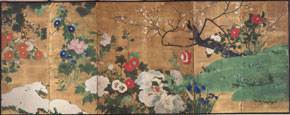
Mixing Vessel with Dionysos and Comic Actors,
Greek, About 390 – 380 B.C., Red-figured
volute krater attributed to the Pronomos
Painter. Terracotta. Lent by the Cleveland
Museum of Art, John L. Severance Fund.
The Art of Ancient Greek Theater, at the Getty Villa The Art of Ancient Greek Theater, on view at the Getty Villa from August 26, 2010 – January 3, 2011, is the first exhibition in the United States in over fifty years to focus on the artistic representation of theatrical performance in ancient Greece]]>
Source: Getty Museum
Assembling international loans of antiquities from many museums and private collections, the exhibitionillustrates the ways in which dramatic performance was depicted in the visual arts of ancientGreece between the fifth and the first centuries B.C. The exhibition is being presented inconjunction with the Getty Villa’s annual outdoor theater performance, Sophocles’ Elektra.
“Ancient art and theater share a strong and enduring connection–one that is inspiredby mythology and the social, cultural, and political realities of life in ancient Greece andRome,” says David Bomford, acting director of the J. Paul Getty Museum. “With thisexhibition and our annual production in the outdoor theater, we are delighted to bringancient theater alive at the Getty Villa and invite our visitors to join us and discover how thosethemes found in ancient times persist today.”
Elaborate costumes, complex choreography, scenic architecture, and the mask—whichcontinues to be an icon for tragedy and comedy—are vividly depicted in the visual arts ofancient Greece.
An introductory section introduces visitors to the architectural and physicalenvironment of ancient Greek theater. The importance of drama to the civic and religious lifein the ancient Greek world is reinforced by a large mural map, locating about one hundredancient theaters in the Mediterranean. The map is complemented by marble sculptures ofactors and poets as well as a model of the Theater of Dionysos in Athens, the home of thefestival of the Great Dionysia, where the plays of Aeschylus, Sophocles, Euripides andAristophanes were originally performed.
The exhibition is organized in three general themes. The first theme is devoted to thehistorical context of ancient Greek performance. Springing from the worship of Dionysos,theatrical performance developed out of the god’s religious rites and festivals. Objects onview depict actors, costumes, masks, choruses and chorusmen, with Dionysos the god oftheater as motivator and benefactor.
The second theme focuses on tragedy and the satyr plays and will present comparativeinstallations of vase-paintings inspired by ancient performances of Athens’ renownedtragedies: Aeschylus’ Oresteia; Euripides’ Medea, Herakles, Children of Herakles, Andromacheand Iphigenia in Aulis; and Sophocles’ Oedipus. Objects representing satyr play will beanchored by the exceptional loan of the great Pronomos Vase from the Museo ArcheologicoNazionale in Naples.
The third theme of the exhibition features comedy. Depictions of comic parodies andfarces, where gods and centaurs share the stage with plotting slaves and thieves, and genrevase-painting represents costumed and masked actors in scenes on ancient stages, includesome of the most vivid painting from the ancient world.
“We hope that our visitors will come away with a rich understanding not only of thecontext of ancient Greek theatrical performance but of the many ways artists interpreted thechoruses and plays they witnessed. These vase-paintings, reliefs and figurines are often theonly evidence we have for many aspects of ancient drama. Significantly, the heightened visualstyle and attention to details such as costumes and choreography result in portrayals ofancient actors, poets, and musicians that give us an immediate sense of their performance onstage,” says Mary Louise Hart, associate curator of Antiquities at the J. Paul Getty Museum,who curated the exhibition.
Follow us on:

